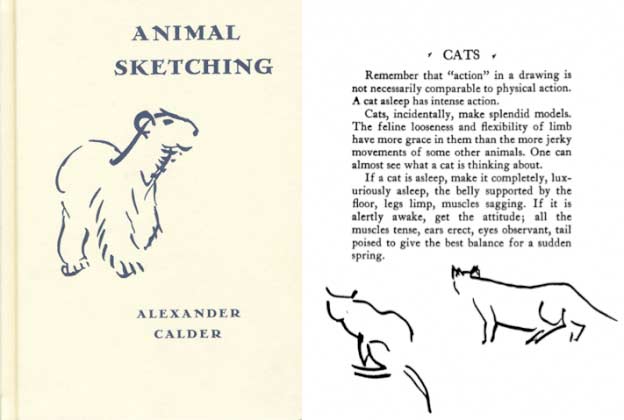Animal sketching can be a fun challenge. The fun is in quickly capturing a likeness of your subject, and the challenge is in accomplishing your sketch with a minimal amount of lines, before your subject decides to change position.

In his 1925 book Animal Sketching, renowned sculptor and inventor of mobiles, Alexander Calder (1898-1975) included sketches and helpful insights, such as following the rhythm of your subject. “When an animal is in rapid motion, or moves so that you do not expect it to return to its original position, leave what you have drawn and start a new sketch. Use a large sheet of paper and make your sketches small. You must work quickly and it saves much time in changing with the animal’s movements. Do not trouble to have your drawings right side up or sequential. Keep rapidly transmitting your impressions of the animal’s movements, and enjoy what you are drawing.”
Calder then goes on to mention animal instincts. “In drawing animals we must have the feeling that they are doing something, no matter how simple the thing may be. In spite of our vast mental superiority, animals have minds and use them. In man, reason has taken the place of instinct to a great extent. Animals think with their bodies to a greater extent than man does. In anger or fright, ears flatten against the head, the hair along the spine rises. The dog at sight of food drools at the mouth, male birds courting display their feathers. There is no self-consciousness: animals are always intent upon the thing they are doing, and we must feel that they are as we sketch them.”
Ready to give it a try? Domestic pets will usually oblige in your household sketching safari by providing an endless stream of poses to fill your paper. Calder felt that cats make splendid models. “If a cat is asleep, make it completely, luxuriously asleep, the belly supported by the floor, legs limp, muscles sagging. If it is alertly awake, get the attitude; all the muscles tense, ears erect, eyes observant, tail poised to give the best balance for a sudden spring.”
Rob Court
Latest posts by Rob Court (see all)
- Drawing With Friends - April 11, 2022
- Frozen in Time: Cellphone Users as Models to Draw - April 8, 2022
- Getting Out & Getting Real - June 20, 2021
- Life Lines: Sketching the Unseen World of Movement - June 20, 2021
- The Ups & Downs of Urban Sketching - May 9, 2021